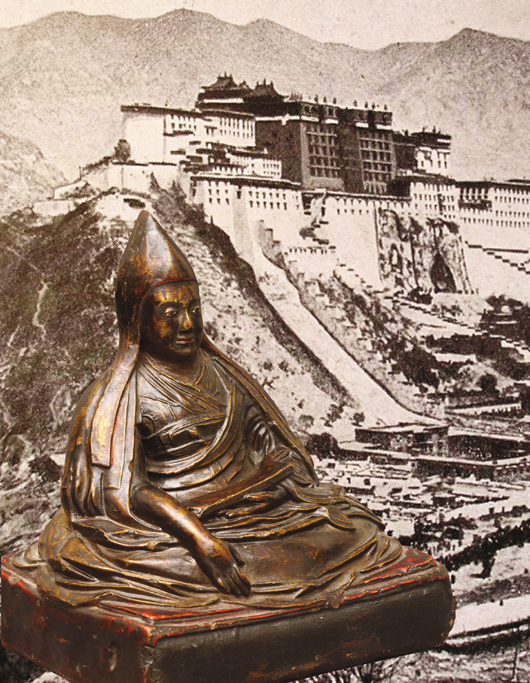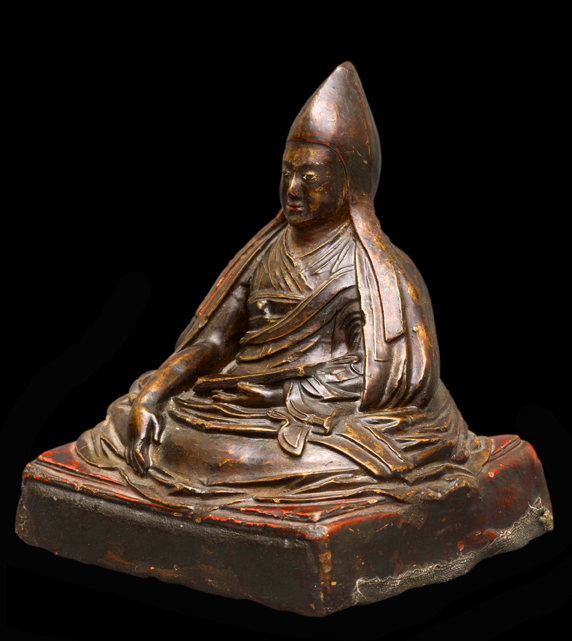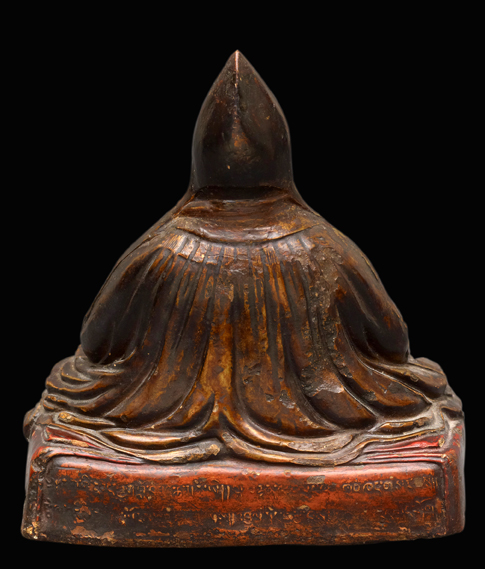| |
 |
|
Ngawang Lobsang Gyatso (1617-1682)
ངག་དབང་བློ་བཟང་རྒྱ་མཚོ་
ngag-dbang blo-bzang rgya-mtsho
The fifth Dalaï-Lama
Potala palace Lhasa 1682-1683
Raw earth. H. 16 cm
The 5th Dalai Lama (1617-1682) was a major political and religious figure in the Tibetan history during the reign of Emperor Kangxi.
Spiritual and temporal leader of the unified country under his authority from 1642, he was the true founder of the Tibetan theocracy and the most powerful Dalai Lama of all.
An exceptional politician, a great administrator and builder, he was also a very prolific writer and an outstanding spiritual master.
Provenance :
This sculpture, which is of major historical and religious interest, is one of the very few Tibetan objects preserved in private hands that we can be certain of coming from the Potala Palace in Lhasa.
- It was offered by the thirteenth Dalaï-Lama to David Macdonald (1870-1962) during his stay with Charles Bell in Lhasa in December 1920 or January 1921.
From July 1909 to October 1924, David Macdonald was the British commercial agent in Yatung and Gyantse in Tibet. He saved the life of the 13th Dalai Lama by helping him cross the Indian border when he was forced to flee from Tibet in January-February 1910.
This sculpture was presented to him eleven years later as a thank-you gift during their various meetings at the Potala palace.
- In 1959, David Macdonald discretely sold it in Darjeeling to a couple of Tibetologists.
- The latter sold it in 1980 to Jean-Luc Estournel, in whose collection it is still kept today.
|
|
|
| |
|
|
Published:
- Ariane Macdonald, Dvags-po Rinpoche and Yon-tan rgya-mtsho : « Un portrait du cinquième Dalaï-Lama » in « Essais sur l’art du Tibet » Paris 1977
- Jean-Luc Estournel : « Angles on Himalayan arts” Paris 1992
- Exhibition catalogue : « Rituels tibétains. Visions secrètes du Vème Dalaï Lama » Musée National des Arts asiatiques – Guimet – Paris 2002
Exhibited :
- « Tibetan rituals. Secret visions of the 5th Dalaï Lama » Musée National des Arts asiatiques – Guimet – Paris, November 6, 2002 – February 24, 2003.
Description of the sculpture:
The 5th Dalai Lama is depicted in traditional form, sitting on a throne of cushions and carpets, crossed legs, dressed in traditional monastic costume, and wearing the classic pandit headdress.
His right arm rests on his knee, his hand falling to the ground, the left hand in the lap holding a book in a meditation position.
He is wearing a phur-bu in his belt, symbolizing his origins and his Nyingmapa friendships. It is true that during his lifetime he always showed a certain favor for this school and its members, easily hiding behind the fact that the Dalai Lama is considered to be an emanation of Padmasambhava. This detail of the phur-bu can be found on two other statuettes of the same figure, one kept at the Museum of Fine Arts in Boston (inv 50.3606), and the other at the Musée Guimet (inv M. G. 24.472).
There is a difference between the eyes, one being almost closed and the other more wide open.
All these details are very important because they correspond exactly to the description made by the regent Sangs-rgyas rgya-mtsho when he relates in the Dukula (biography of the 5th Dalai Lama) the death of his master, in his presence, in this exact position, one eye closed, the other open.
The idea of the author of this sculpture was therefore clearly to create a portrait of the 5th Dalai Lama as he was at the moment of his last breath just before his right eye closed for good.
The back of the cushion throne bears an inscription. |
 |
|
|
| |
 |
Inscription :
The inscription on the back, which is in places difficult to read, was translated by Mrs. Ariane Macdonald (Director of Studies in Tibetan History and Philology at the Ecole Pratique des Hautes Etudes de Paris), Dvags-po Rinpoche (Recognized by the 13th Dalai Lama as the reincarnation of the previous Dvags-po Rinpoche, trained at Dvags-po monastery and at the Buddhist University of Drepung Monastery ('bras-spungs) near Lhasa, before being sent to Paris by the 14th Dalai Lama in 1959 to assist French tibetologists. ) and Yon-Tan Rgya-Mtsho (Yon-tan-rgya-mtsho mDo smad-pa Tibetologist, 1932-2002) for their 1977 study.
Ngag-gi dbang phyug blo-bzang rgya-mtsho yi //
Sku-brnyan (kyablung lhun) grub khang-gsar-bas //
Spel ‘dis…
‘bral-med brce-bas sprul-sku myur ‘khrung-shog //
Which translates as:
"That by spreading this statue of Ngag-gi dbang phyug blo-bzang rgya-mtsho
By (the organization or person whose name ends with) khang-gsar,
May his affection not be dissociated from us, and may his reincarnation be quickly born."
This inscription clearly attests that the statue was made in order to facilitate the rapid discovery of the new incarnation of the deceased 5th Dalai Lama, in a child destined to become the 6th Dalai Lama.
It is very likely that some of the rites, meditations and divinations that presided over the search for this new incarnation were done around this statue.
Datation :
The fact that this sculpture was erected to promote the discovery of the new incarnation of the Dalai Lama implies that this must have been done between the day of his death on the 25th day of the second month of 1682 and the recognition of Tshangs-dbyangs rgya-mtsho as a reincarnation, and thus 6th Dalai Lama, at the end of the year 1683. |
|
|
|
|
Author and material :
The author of this sculpture is not precisely known. Unfortunately, the inscription has been partly erased in this place, and tibetologists have not been able to determine exactly which organism or person might have been the one whose name ends in khang-gsar, which may have been translated as "new house".
In view of the historical context of the moment, this can only be the regent Sangs-rgyas rgya-mtsho in person or one of the few members of the "private house" of the 5th Dalai Lama, all bound by the oath to keep the secret of the death of their master until the enthronement of the new incarnation.
The use of modelled raw earth, a technique used for the ornamentation of the first temples throughout Central Asia and thus in Tibet, which is known to have been practised by some high-ranking lamas, was the only way to avoid having to call in an artist from outside the group for the erection of such an object.
In his study. Mrs. Macdonald makes a most judicious comparison with a self-portrait also in clay, executed in 1630 by the Zhva-dmar Tulku. The strong similarities between the two pieces indicate that, beyond the evidence of a tradition of sculpting portraits of religious figures in the seventeenth century, high dignitaries were skilled enough to execute perfect little sculptures in an easily malleable material.
The fact that the Regent Sangs-rgyas rgya-mtsho has gone down in history as one of the great patrons of the arts and director of the artistic works of the Potala Palace, and that the sculpture represents the 5th Dalai Lama as he saw him give his last breath in his sole presence, may suggest with a very high probability that he could be the author.
The used material is not just any earth, but has probably been subjected to purification.
Until 2002 and its loan to the Musée Guimet, given its weight and hardness, the statuette was considered to be made of terracotta.
In 1982, an attempt at dating by the thermoluminescence process revealed that the earth was so pure that it did not contain the usual natural crystals and other impurities that would allow this technique to be used.
In 2002, Béatrice Beillard, the Musée Guimet conservator who prepared it for the exhibition, carried out an examination which determined that it was in fact dried, uncooked raw clay.
It cannot be excluded that powders of organic matter coming from the very person of the 5th Dalai Lama or sacred substances were mixed with this "purified" earth, to reinforce its spiritual, even magical power, and to guide the Regent and the few people bound by the secret in their search for the new incarnation. |
|
|
|
Historical background :
The 5th Dalai Lama was born in 1617 into the family of the Dukes of 'Phyong-rgyas, the cradle of the ancient Tibetan monarchy. At this time Tibet has been tormented for more than a century by a civil war which opposes various religious parties for the power on the country. These movements were stirred up by the Ming emperors who since the reign of Yongle have done everything possible to pit the various parties against each other.
The position of the family of the future 5th Dalai Lama is so important and potentially "key" in the outcome of this conflict that the child was necessarily destined for a brilliant future.
He received his first name from the famous Jonangpa master Taranatha. For a time it was believed that he was the reincarnation of the Karmapa, and then of other great religious figures, before, not without difficulty, he was finally admitted as the reincarnation of the Fourth Tulku of dGa'-ldan pho-brang, one of the monastic palaces of Drepung Monastery (one of the three main Gelukpa monasteries in the vicinity of Lhasa).
It is therefore clear that the child found himself at the heart of the perpetual struggle for influence between the Kagyupa and the Gelukpa, the advantage taken by the latter having to become decisive.
Enthroned in 1622, the young tulku was to become one of Tibet's greatest statesmen, and his actions have left their mark on the politics, arts, letters, and religion of the "Land of the Snows" to this day. In 1642, he founded the Tibetan system of government as it was to remain until 1959. This government took the name of the monastic palace of the Dalai Lama in Drepung monastery: dGa'-ldan pho- brang.
The creation of this government put an end to years of turmoil by unifying Tibet under the triple authority of the Mongolian prince Gushri Khan, who received the title of "King of Tibet" from the Dalai Lama and his administrator, Bsod-nams chos-'phel, who became the 1st regent (sde-srid).
Because of his origins, he was to become a charismatic figure for the Nyingmapa, and the Gelukpa. As ruler of Tibet, one of his first concerns was not to appear too closely linked to the Gelukpa, and it is certainly for this reason that in a desire for national unity around him and the institutions he had set up, he decided in 1645 to build the Potala in Lhasa, on the site of the former palace of the great king Songtsen Gampo, to whom legends attribute the introduction of Buddhism into Tibet. At the same time, it gave him the opportunity to leave the Drepung monastery. For forty years, this government was to function perfectly and established its authority over the country.
On the fourth day of the first month of 1682, the Nyingmapa master Padma 'phrin-las sent a message to the regent Sangs-rgyas rgya-mtsho, in the Potala, reporting visions of bad omens on his "disciple and master", the Fifth Dalai Lama. He insisted that certain rites should be performed for his health and that he should go on a retreat. Eleven days later, following the prescriptions of his "disciple and master", the "Great Fifth" officially entered into seclusion. Subsequently this retreat permitted to withhold the news of his death from almost everyone, especially from the Emperor of China.
On the twenty-fifth day of the second month, the Dalai Lama, feeling his end very near, summoned the regent, and asked him to hide his death, assuring him that he would be able to recognize his reincarnation. In case of problems, he and the ministers would only have to consult the goddess Lha-mo for answers to their questions. After such consultation, they decided to keep the secret until the advent of the successor. The only outsider who was informed was Gter-bdag gling-pa (1646-1714), the famous discoverer of hidden texts, who was one of the Dalai Lama's closest Nyingmapa "master and disciple". The secret had to be kept until the official enthronement of the sixth Incarnation in 1697, in order to allow the government to maintain itself.
This government could function without the Dalai Lama, but on his behalf, as long as the Emperor of China and the anti-Gelukpa Tibetan leaders were not informed of his death. It was therefore essential for the regent Sangs-rgyas rgya-mtsho and his partners to discover as soon as possible the new body taken by their master and to do most of his education in secret.
Our sculpture was created in this very specific background.
Our figure must have served as a model for at least two bronze editions of post-mortem portraits of the Dalai Lama.
The first one, of which one copy is kept in a private collection, is close in all respects to our one, except for a drier, less detailed treatment. The inscription has disappeared, only giving the name of the character. This edition must have seen the light of day between the official announcement of the death of the "Great Fifth" in 1697, and the disappearance of the Vl° Dalai Lama in 1705.
The second edition is also almost identical, but on all known specimens, one of which was exhibited at the exhibition "Gods and demons of the Himalayas" in Paris in 1977 (n°287), the phur-bu has disappeared. This second edition is only an expurgated replica of the previous one, a clear sign of anti-Nyingmapa repression. This second series of objects probably began to appear after 1750, when bsKal-bzang rgya-mtsho, 7th Dalai Lama recovered the temporal power of his 5th incarnation, after the successive failures of three civil governments supported by the emperor of China.
This example clearly demonstrates the reality of the notion frequently put forward by G. Béguin in 1977 during the exhibition "Gods and Demons of the Himalayas", of more or less late replicas of earlier originals.
At once probably the last portrait of the 5th Dalai Lama, fixed at the moment of his death by one of his closest collaborators, an object of worship intended to support meditations and rites in order to find the new incarnation, the centerpiece of a major state secret for the history of Asia at the end of the 17th century, and more precisely for the relations between the Tibetans, the Mongols, and the Emperor Kangxi, this remarkable sculpture is nonetheless an exceptional artistic testimony. |
| |
|